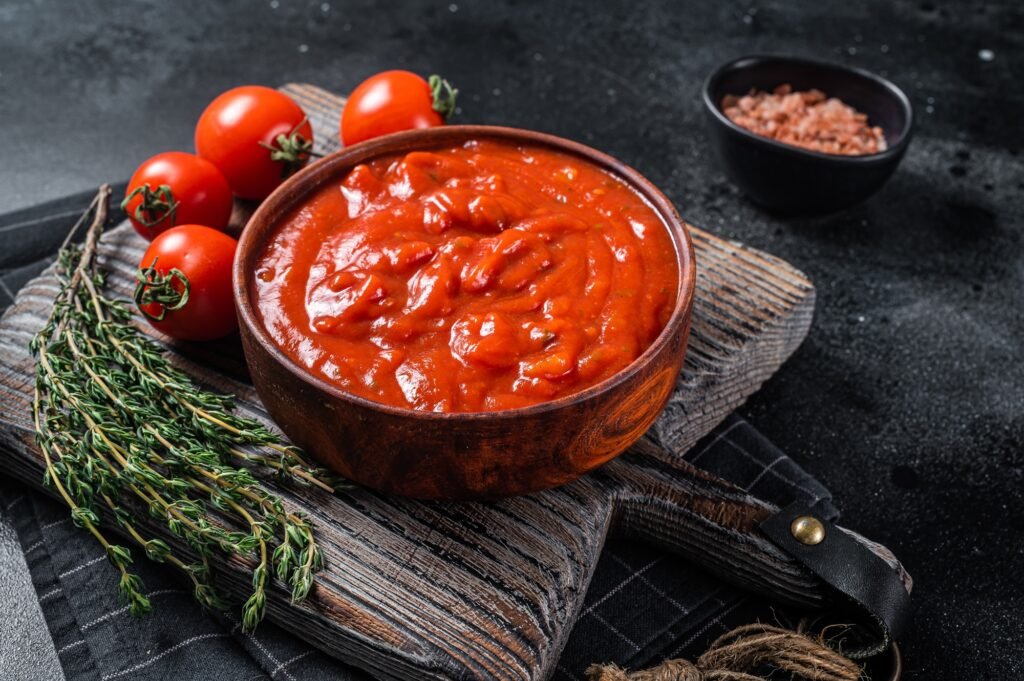1. Selecting the Perfect Tomatoes
The foundation of premium tomato sauce lies in superior raw materials. Unlike table tomatoes, processing varieties like Roma, San Marzano, or Heinz 3402 are chosen for their:
- High solids content (12-15% vs. 5% in fresh-market tomatoes)
- Thick flesh and low moisture, ideal for concentrated flavor
- Balanced acidity (pH 4.3-4.9) for natural preservation
Did You Know?
Top producers source tomatoes within 8 hours of harvest to preserve freshness. Fields are typically located within 50km of processing plants to minimize nutrient loss during transit.
2. The Science of Processing
Step 1: Washing & Sorting
Tomatoes pass through:
- Floatation tanks to remove leaves and stems
- High-pressure sprayers eliminating 99.9% of surface microbes
- Optical sorters using AI to discard defective fruits at 15 tons/hour
Step 2: Thermal Breakdown
The “Hot Break” method (88-104°C for 1-2 minutes):
- Deactivates pectinase enzymes to maintain thickness
- Enhances lycopene bioavailability by 300% compared to raw tomatoes
Step 3: Concentrating the Goodness
Evaporators reduce water content through:
- Triple-effect vacuum evaporation at 65°C (preserves vitamin C)
- Refractometer checks ensuring 28-32% solids concentration
3. Canning: The Preservation Revolution
Modern canning technology ensures safety and nutrition:
| Process Stage | Key Parameters | Benefit |
|---|---|---|
| Filling | Nitrogen-flushed cans | Prevents oxidation |
| Seaming | Double-seam at 0.23mm precision | Airtight microbial barrier |
| Retorting | 121°C for 20-45 mins | Kills Clostridium botulinum spores |
| Cooling | Rapid chilled water spray | Locks in flavor |
Innovation Spotlight:
Some premium brands now use BPA-free lacquered cans and oxygen-absorbing liners to extend shelf life to 3+ years without preservatives.
4. Quality Control: Beyond Industry Standards
Every batch undergoes:
- pH verification (critical for acidified foods regulation)
- Texture analysis via Brookfield viscometers
- Lycopene quantification through HPLC testing
- Microbiological screening for yeast/mold counts
A single 500ml can represents over 30 quality checkpoints from farm to final product.
5. Why Canned Beats Homemade (Scientifically)
While fresh tomatoes have appeal, canned sauce offers unique advantages:
Nutritional Superiority
- Lycopene absorption increases 400% after thermal processing (Journal of Agricultural and Food Chemistry)
- Vitamin retention: 90% of vitamin C remains after proper canning vs. 40% loss in 7-day fridge storage
Economic & Environmental Wins
- 1 can = 1.5kg fresh tomatoes (reducing transport emissions)
- Zero waste: 100% of processing byproducts (skins, seeds) become animal feed or biofuel
Conclusion
The journey from farm to jar is a symphony of agriculture, technology, and gastronomy. Today’s canned tomato sauces deliver unparalleled consistency, nutrition, and sustainability—far removed from the mushy, metallic-tasting products of the past. As consumers rediscover the art and science behind this pantry essential, premium canned tomato sauce is reclaiming its place as a chef’s secret weapon and a home cook’s reliable ally.
Ready to Experience the Difference?
[Explore our premium tomato sauce range] today—where every can tells a story of quality from soil to shelf.

_画板-1-scaled-1-e1753069611495-300x238.png)
_画板-1-scaled-1-e1753069611495-r92g6ranye9uox3dh6vr3oda8no8cia2ellx6xvoug.png)